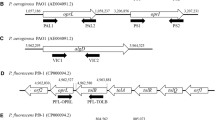Abstract
With bacterial ring rot affected potato lots must be decontaminated under official control without causing a risk for the dissemination of the disease. Therefore, at the Bavarian State Research Center for Agriculture (LFL) in Freising a research project is conducted to investigate, which characteristics (temperature and retention period) during anaerobic digestion must be given to eliminate Clavibacter michiganensis sub-sp. sepedonicus. Most biogas plants are run at temperatures between 35 and 55°C. Hence, at first a method was developed to study and describe thermosensitivity of the organism in digester material in the relevant temperature range. For this purpose the streptomycin resistant mutant Cms 4053 strep (NCPPB collection, UK) was used. Viable organisms could be exactly quantified after being incubated for ten minutes at different temperatures by combining an enrichment step on growing medium supplemented with streptomycin with real-time PCR (ABI Prism 7000) using TaqMan® probes (TaqMan® BIO-PCR). It could be shown, that the number of colony forming units (cfu) linearily declines between 35 and 55°C with rising temperatures during equal incubation time periods. Every temperature increase of 8°C reduced the number of cfu by a log10 unit.
Zusammenfassung
Eine Kartoffelpartie, welche mit Bakterieller Ringfäule befallen ist, muss unter behördlicher Aufsicht so entsorgt werden, dass davon kein Risiko für die Verbreitung der Krankheit ausgeht. Deshalb wird in einem Forschungsvorhaben an der Bayeri-schen Landesanstalt für Landwirtschaft (LfL) in Freising un-tersucht, welche Parameter (Temperatur und Verweildauer) im Biogasprozess vorherrschen müssen, um Clavibacter michi-ganensis subsp. sepedonicus sicher abzutöten. Die meisten Biogasanlagen werden bei einer Temperatur von 35 bis 55°C betrieben. Deshalb wurde zuerst ein Verfahren entwickelt, um die Temperatursensitivität des Erregers in Gärsubstrat in diesem Temperaturbereich untersuchen und beschreiben zu können. Dazu wurde die streptomycinresistente Mutante Cms 4053 strep (NCPPB collection, UK) verwendet. Die exakte Quantifizierung lebensfähiger Individuen nach zehnminüti-ger Inkubation bei verschiedenen Temperaturen gelang, indem ein Anreicherungsschritt auf streptomycinhaltigem Nährmedium mit der Realtime-PCR (ABI Prism 7000) unter Ver wendung vo n Taq Man®-Sonden kombiniert wurde (Taq-Man® BIO-PCR). Es konnte gezeigt werden, dass die Anzahl koloniebildender Einheiten (KBE) zwischen 35 und 55°C bei gleicher Inkubationsdauer mit steigender Temperatur linear abnimmt. Eine Temperaturerhöhung um 8°C bewirkte jeweils eine Reduzierung der KBE um eine Log10-Einheit.
Similar content being viewed by others
References
Anonymous, 1993: Council Directive 93/85/Eec: Off. J. Eur. Commun. L259, 18.10.93.
Anonymous, 1998: Verordnung über die Verwertung von Bioabfällen auf landwirtschaftlich, forstwirtschaftlich und gärtnerisch genutzten Böden (Bioabfallverordnung–Bio-AbfV) vom 21.September 1998: Bgbl. I, 2955.
Anonymous, 2006a: Commission Directive 2006/56/EC of 12 June 2006 amending the Annexes to Council Directive 93/85/EeC on the control of potato ring rot. Off. J. Eur. Union L 182/1, 4.7.2006.
Anonymous, 2006b: Clavibacter michiganensis subsp. sepedoni-cus. EppO Bulletin 36, 99–109.
Bach, H.-J., I. Jessen, M. Schloter, J.C. Munch, 2003: A Taqman-Pcr protocol for quantification and differentiation of the phytopathogenic Clavibacter michiganensis subspecies. J. Micobiol. Meth. 52, 85–91.
Dela Cruz, A.R., M.V. Wiese, N.W. Schaad, 1992: A semiselective agar medium for isolation of Clavibacter michiganensis subsp. sepedonicus from potato tissues. Plant. Dis. 76, 830–834.
Jansing, H., 1991: Nachweismethoden für Clavibacter michi-ganensis ssp. sepedonicus, Erreger der bakteriellen Ringfäule an Kartoffeln. Diss. Univ. Göttingen, Germany.
Jansing, H., K. Rudolph, 1998: Physiological capabilities of Clavibacter michiganensis ssp. sepedonicus and development of a semi-selective medium. J. Plant. Dis. Prot. 105, 590–601.
Jones, P. W., 1976: The effect of temperature, solids content and pH on the survival of salmonellas in cattle slurry. Br. Vet. J. 132, 284–293.
Kaemmerer, D., M. Kappen, M. Friedrich-Zorn, L. Seigner, 2006: Bakterielle Ringfäule der Kartoffel–Zellzahlentwicklung in gelagerten Knollen. Kartoffelbau 57, 504–508.
Lelliott, R.A., D.E. Stead, 1987: Methods for the diagnosis of bacterial diseases of plants. Blackwell Scientific Publications, Oxford.
Mikkelsen, L., J. Elphinstone, D.F. Jensen, 2006: Literature review on detection and eradication of plant pathogens in sludge, soils and treated biowaste. HorizONTAL-HyG DL 2/5 Report, SspI-CT-2004–513660, 53 p.
Roozen, N.J.M., J.W.L. vAN VUURDE, 1997: Development of a semi-selective medium and an immunofluorescence colony-staining procedure for the detection of Clavibacter michiganensis subsp. sepedonicus in cattle manure slurry. Neth. J. Pl. Path. 97, 321–334.
Sächsische Landesanstalt FüR Landwirtschaft, 2005: Zur Phytohygiene von Kartoffelabfällen. Schriftenreihe der Sächsischen Landesanstalt für Landwirtschaft Heft 5/2005.
Sächsische Landesanstalt FüR Landwirtschaft, 2006: Zur Phytohygiene von Kartoffelabfällen. Schriftenreihe der Sächsischen Landesanstalt für Landwirtschaft Heft 17/2006.
Schaad, N.W., Y. BERTHIER-SCHAAD, A. SECHLER, D. KNORR, 1999: Detection of Clavibacter michiganensis subsp. sepedonicus in potato tubers by BiO-PcR and an automated real-time fluorescence detection system. Plant Dis. 83, 1095–1100.
Seigner, L., D. Kaemmerer, M. Kappen, 2007: Realtime-Pcr zum Nachweis von Clavibacter michiganensis subsp. sepedonicus und Ralstonia solanacearum–Grundlagen, Methode und praktische Hinweise. Gesunde Pflanzen 59, 101–106.
Steinmöller, S., P. Müller, C. Büttner, 2007: Effect of composting and pasteurisation on two important quarantine pests of potato. Commun. Agric. Appl. Biol. Sci. 72, 341–351.
Termorshuizen, A.J., D. Volker, W.J. Blok, E. ten Brummeler, B.J. Hartog, J.D. Janse, W. Knol, M. Wenneker, 2003: Survival of human and plant pathogens during anaerobic mesophilic digestion of vegetable, fruit, and garden waste. J. Soil Biol. 39, 165–171.
Author information
Authors and Affiliations
Corresponding author
Rights and permissions
About this article
Cite this article
Kaemmerer, D. Quantification of viable cells of Clavibacter michiganensis subsp. sepedonicus in digester material after heat treatment by TaqMan® BIO-PCR. J Plant Dis Prot 116, 10–16 (2009). https://doi.org/10.1007/BF03356280
Received:
Accepted:
Published:
Issue Date:
DOI: https://doi.org/10.1007/BF03356280




